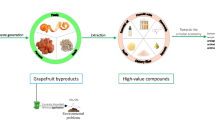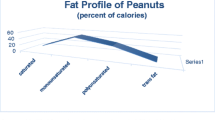Abstract
The quality and safety of rapeseed are greatly affected by glucosinolate and erucic acid. To determine the quality of a new variety, ‘Kangyu’ was cultivated at 3 different regions and analyzed to evaluate oil quality and glucosinolates contents. The new cultivar accumulated 38–43%(w/w) of oil and 5–14 μmol/g of glucosinolates, whereas the local race contained 43% and 52 μmol/g, respectively. The total glucosinolates in ‘Sunmang’ was above the permissible limit. All ‘Kangyu’ samples had safe fatty acid compositions but the local race contained 43% of erucic acid (C22:1) that is far from the International Standard. The contents of oleic (C18:1), linoleic (C18:2), and linolenic acid (C18:3) in ‘Kangyu’ were 61–65, 21–23, and 9–10%, respectively. Consequently, ‘Kangyu’ was good oil source in Korea in terms of erucic acid (C22:1) and total glucosinolates for human health.
Similar content being viewed by others
References
Sharpe AG, Lydiate DJ. Mapping the mosaic of ancestral genotypes in a cultivar of oilseed rape (Brassica napus) selected via pedigree breeding. Genome 46: 461–468 (2003)
Green TJ, Innis SM. Low erucic acid canola oil does not induce heart triglyceride accumulation in neonatal pigs fed formula. Lipids 35: 607–612 (2000)
Clandinin MT, Yamashiro S. Dietary factors affecting the incidence of dietary fat-induced myocardial lesions. J. Nutr. 112: 825–828 (1982)
Hayes JD, Kelleher MO, Eggleston IM. The cancer chemopreventive actions of phytochemicals derived from glucosinolates. Eur. J. Nutr. 47(Suppl 2): 73–88 (2008)
Mawson R, Heaney RK, Zdunczyk Z, Kozlowska H. Rapeseed meal-glucosinolates and their antinutritional effects. Part 3. Animal growth and performance. Nahrung 38: 167–177 (1994)
Tripathi MK, Mishra AS. Glucosinolates in animal nutrition: A review. Anim. Feed Sci. Tech. 132: 1–27 (2006)
Stjohn LC, Bell FP. Extraction and fractionation of lipids from biological tissues, cells, organelles, and fluids. Biotechniques 7: 476–481 (1989)
Bhardwaj HL, Hamama AA. Oil, erucic acid, and glucosinolate contents in winter hardy rapeseed germplasms. Ind. Crop. Prod. 12: 33–38 (2000)
Morrison WR, Smith LM. Preparation of fatty acid methyl esters and dimethylacetals from lipids with boron fluoride-methanol. J. Lipid Res. 5: 600–608 (1964)
ISO 9167-1:1992. Rapeseed — Determination of glucosinolates content — Part 1: Method using high-performance liquid chromatography. International Organization for Standardization, Geneva, Switzerland. pp. 1–9 (1992)
Rakow G, Raney JP. Present status and future perspectives of breeding for seed quality in Brassica oilseed crops. pp. 181–185. In: Proceedings of 11th International Rapeseed Congress. Royal Veterinary and Agricultural University, Copenhagen, Denmark (2003)
Communities CDotE. Relating to the fixing of the maximum level of erucic acid in oils and fats intended as such for human consumption and in foodstuffs containing added oils or fats. Off. J. Eur. Community 202: 35–37 (1976)
Kris-Etherton PM, Hecker KD, Binkoski AE. Polyunsaturated fatty acids and cardiovascular health. Nutr. Rev. 62: 414–426 (2004)
Simopoulos AP. The importance of the ratio of ω-6/ω-3 essential fatty acids. Biomed. Pharmacother. 56: 365–379 (2002)
Bonnesen C, Eggleston IM, Hayes JD. Dietary indoles and isothiocyanates that are generated from cruciferous vegetables can both stimulate apoptosis and confer protection against DNA damage in human colon cell lines. Cancer Res. 61: 6120–6130 (2001)
Velasco P, Cartea ME, Gonzalez C, Vilar M, Ordas A. Factors affecting the glucosinolate content of kale (Brassica oleracea acephala group). J. Agr. Food Chem. 55: 955–962 (2007)
Ciska E, Martyniak-Przybyszewska B, Kozlowska H. Content of glucosinolates in cruciferous vegetables grown at the same site for two years under different climatic conditions. J. Agr. Food Chem. 48: 2862–2867 (2000)
Author information
Authors and Affiliations
Corresponding author
Rights and permissions
About this article
Cite this article
Park, JT., Wang, P., Choi, SH. et al. Quality and safety of a new rapeseed ‘Kangyu’ cultivated at different regions in Korea. Food Sci Biotechnol 21, 273–277 (2012). https://doi.org/10.1007/s10068-012-0036-y
Received:
Revised:
Accepted:
Published:
Issue Date:
DOI: https://doi.org/10.1007/s10068-012-0036-y




